For those of you who don’t do replays of the dead ball era, (and the return to running in the 80’s) then you really in my opinion missed a truly interesting period of baseball. Those days there were power hitters, although not by today’s standards, but there were still hitters you did not serve a first pitch fastball to.
Those were the days of pitching, fielding and running. Most games featured one or two pitchers and the scores most of the time were 4-2, 2-1 with the occasional wild scoring game, or blowout thrown in. When rolling my original season replay of 1901, the minimum number of steals to get into the top ten was 47 in each league. Most were scattered between 47-60 with Frank Chance (92) and John McGraw (95) the leaders.
These games were rolled on the “old charts”. To get a better idea of how most of my lineups looked at the top I will use Chance, the leadoff hitter and NL stolen base record holder and the number two hitter Charlie Dexter. Charlie does not have the type of card I would “prefer” to have bat second, but Topsy Hartsel, who IS what I would prefer was better suited for the third spot with his 3 sevens were needed as the rest of the lineup was pretty bad and despite the three 31’s he ended up batting third, and was arguably as valuable to the team than Chance was.
Anyway looking at the charts that were made to use with these cards Charlie’s card actually is pretty good on the hit and run chart. The 13-41 normally would be bad, and while my screenshot does not show it, it is actually a single, runner to third, which is just like having three 31’s. The 13’s don’t cause the runner to be out stealing so it’s like having 3 14’s on the card. Additionally, the dice result of 1 is still a home run, so other than the 45-37 there is really not any reasons not to run every chance I could.
For McGraw, and number two hitter “Turkey Mike” Donlin it was even more devastating. Now look at the “old charts” with runners on the corners.
As you can see there really is no reason NOT to use it is if you get that gut feeling that you are going to roll the 13, or 45 (and at times I got that feeling) there is almost NO punishment for running like mad. 1 is still a homer, and you get the 31’s for singles, but look at 13 and 14. If your runner had at least one first column 11 they are safe anyway.
Fast forward to 1903 when I purchased the “new charts” and the “new cards” By new cards, I mean that unlike the original issue 1901 set which I can only assume was printed sometime in the 1980’s (those more familiar when the number 12 was at 52 can better verify) and used what limited stats were available to them at that time. The 1903 cards were made in 2012, with significantly more advanced data. Unfortunately, because they were made to be used with the “new charts” you get a much different set of results.
I give to you the 1903 Pirates leadoff hitter Jimmy Sebring. As you can see, Jimmy has a solid card, although nothing that will put you in Rickey Henderson conversations. On the “old charts” he probably would have had 50 steals, which is granted much more than the 20 he actually had, but if you don’t have the “old charts” and have an original issue set, like my 1901 and 1908 seasons then your steal results won’t come close. In fairness to APBA, the results for my replay were somewhat close. (of course having second slot hitter like Ginger Beaumont, who won his only batting title helps) By that, I still had a couple of jackrabbits who never got tossed out, but the overall averages dropped.
In 1903 the league average to get into the top ten still was about 47 in the NL, but the AL dropped to 38. Frank Chance actually passed his 1901 mark with 95 steals, but the AL leader dropped to 59.
Fast forward even further to my 2015 ILLOWA debut and I have Francisco Lindor at the top of the lineup and Danny Espinosa batting second (my team batting average is well below what it should be) almost out of habit, I call for the hit and run, it’s a 13, and neither I or the manager I played think anything about it at first, but before I roll again we take a look at the charts and sure enough he is out. You are only successful on a 14. Also, note that while you cannot see it on the photo, the home run is now dropped to a double, and the double results that were also good on the old charts are now singles.
Additionally, using hit and run with runners on the corners is now like asking “may I please have my runner thrown out?” There are no successful steals except for the 65-35, and again all the power numbers are reduced to singles.
So if you do venture to old school baseball, please be sure to use the charts that are “era accurate” for lack of a better term.




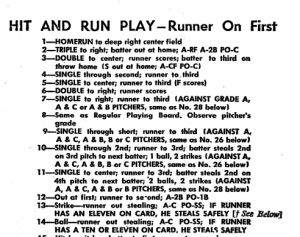
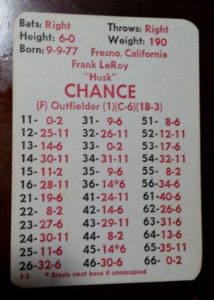
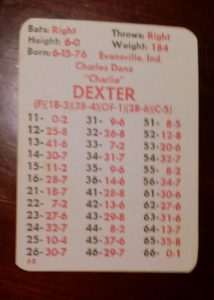
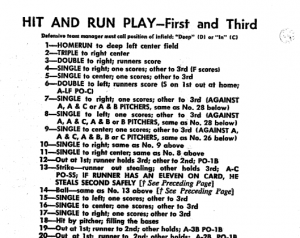
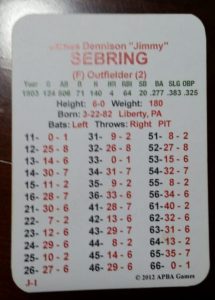
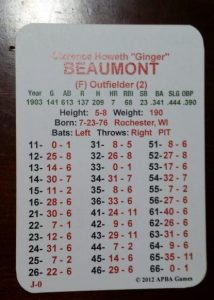
Good stuff, Scott. This is what I wish I more time to write.
Tom
You know my thoughts. Old charts!
Yep. I actually use both my old brown hit and run booklet AND the new one. When I want to goose a runner to go, I use the old chart. When I really intend a hit and run, I use the new one. I just say which before I roll.
Absolutely awesome analysis. Thank you.
Good analysis, Scott. My view is that the old boards are “more fun” but the new boards are more accurate. A good example: In our FTF in Grand Rapids, we used the old boards and I had Jimmie Foxx bat no. 2 behind a Ty Cobb(11 on his card) because Foxx had six 14s and five 13s. I have used Harmon Killebrew for the same role. Clearly, Jimmie Foxx and Killebrew were never used this way in real life and hitters with lots of 13s are not good hit and run batters anyway in real baseball. The new boards make “APBA ball” closer to real baseball. For that reason, I like them better.
Hi Dick,
I think that’s pretty much how I felt, and the reason for the article. I had several teams from 1901 and 1905 that would never bat second, but you make your lineups to win based on the charts you play.
But just because you have the cards set to maximize the charts you still have to get the right dice rolls.
Which charts should I use for my 1908 replay? I’ll be using lineups from sporting life magazine. I hAve the 66’s charts
Hi Robert,
I was out of the APBA world when the “66 chart book” was issued, so that would depend on two things.
What year were the cards printed and what year was the book printed. If the cards were after the 1980’s I would recommend the 66 book, which I can guess came out in the 90’s.
If the cards are prior to the 1980’s I would recommend the old charts. Hope this makes sense and helps.
Yes that makes sense. I have 2012 cards and my book was released in 2006.
Those new charts make it even more difficult for the dead ball teams and teams like the 85 Cardinals to compete against the teams who are dominating the APBA tournaments
like the 27 Yankees, 98 Yankees, 95 Indians etc . Increasing the number of ZZ’s for pitchers in the dead ball era with low walk ratios would help a lot. I have never seen the new boards- there goes my strategy!
Hi Martin,
To be honest, in the tournaments I don’t run as much as in my replays. The reason for that is in most tournaments you will be facing more A and B pitchers than C and D pitchers, so I am more likely to lay a bunt down in some situations.
I don’t know if you have purchased any of the newer issued dead ball teams, but they have gotten much better at the pitching ratings. There are a couple of ZZ pitchers here and there, and one or two K’s.
The XC cards allow for more versatility in replays, and the overall results are much more in line with reality. I wrote an article about the XC’s that you may want to review.